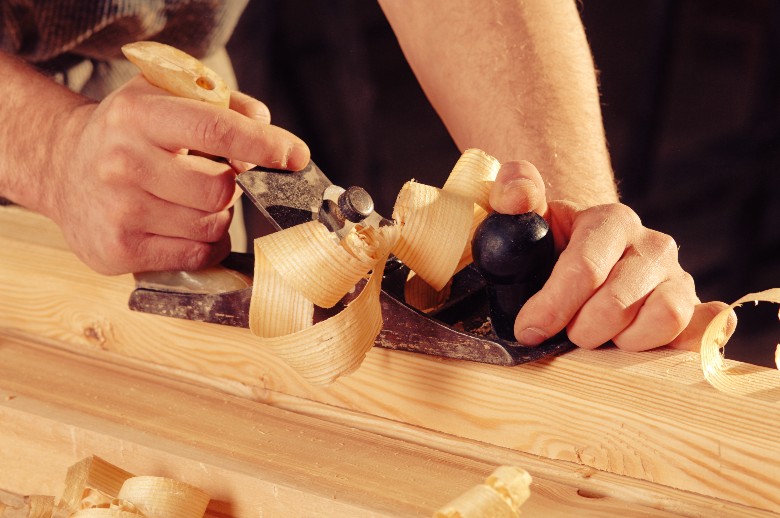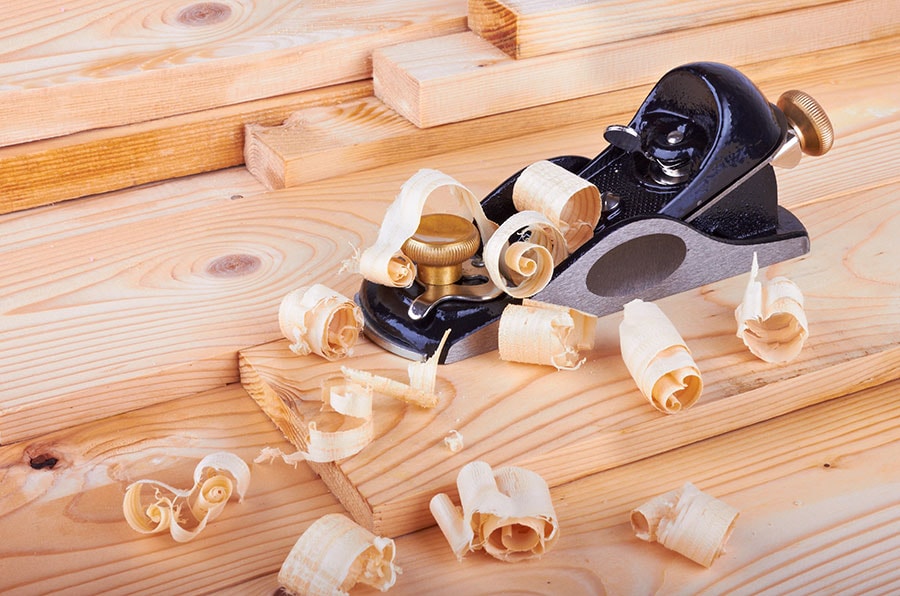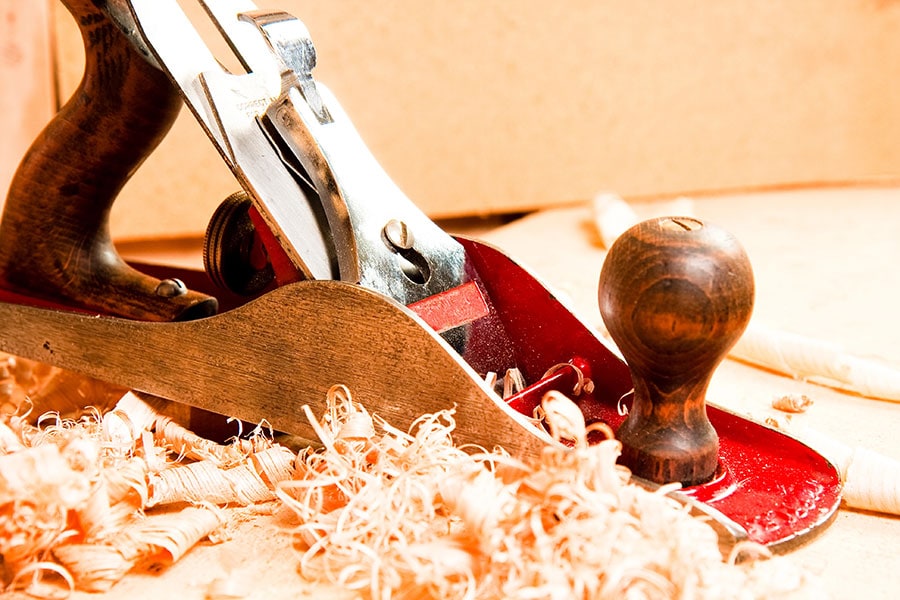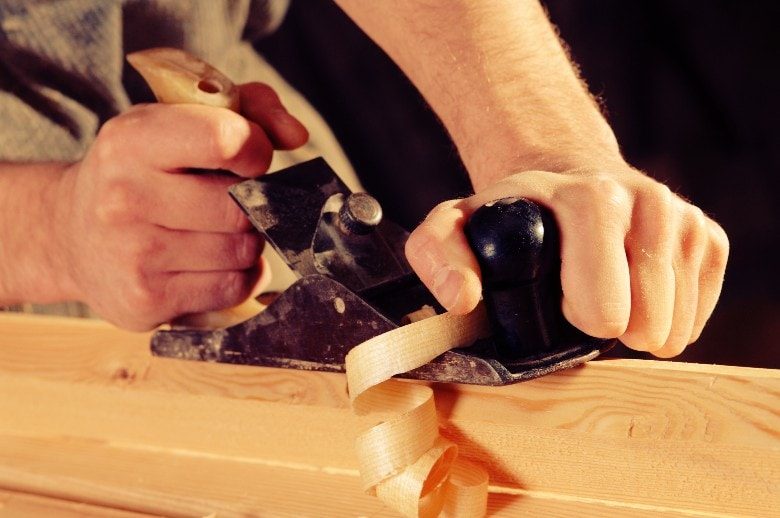As one of the oldest professions and hobbies in the world, woodworking continues to innovate through the development of new and better tools. However, there is a saying that if something is not broken, then there is no reason to fix it, and this aphorism can easily be applied to many tools used for woodworking.
While auger drills and various types of saws may be better suited when fueled by electricity in the form of power drills and numerous types of power circular saws, a good manual hand plane bucks this trend, while there are plenty of power planes available, you give up a fair amount of precision and control to get quicker, easier action.
While this trade-off might work well enough for general contracting work that will likely be covered up, it does not produce the best results for masterful woodworking projects. That is why this article examines the humble wood plane, breaking down the different types of manual wood planes and their uses.
TL;DR: Main Types Of Planes You Should Know About:
- Block Planes: 3 to 7 inches in length. Block planes are used for minor cutting, shaping, and cleaning tasks such as chamfering, leveling corners, or removing glue.
- Bench Planes: the most commonly used plane in Western woodworking. Bench planes normally range from 5 to 24 inches in size, depending on their purpose.
- Smoothing Planes: 7 to 10 inches in length. Smoothing planes are used to remove fine shavings off of wood to create a smooth surface.
- Jack Planes: 12 to 18 inches in length. The jack plane is the general-purpose plane used for sizing timber and general smoothing work.
- Jointer Planes – 20 to 24 inches in length. Jointer planes are designed to shave off large chunks of rough lumber to create a level surface on the wood.
- Bevel-Up Planes – A bevel-up plane has a blade where the bevel sits on the top side of the blade as opposed to the bottom on regular bevel-down bench planes.
- Joinery Planes – small specialty planes that are used to create specific types of joints. Not to be confused with jointer planes.
- Japanese Planes – planes which are designed to be pulled instead of pushed like western bench planes.
Types Of Woodworking Planes:
Block Planes

- ST PLANE BLOCK
- ST PLANE BLOCK
- ST PLANE BLOCK
Block planes are far more similar to smoothing planes than any of the other types in that they are on the smaller side, but block planes take this to a whole new level. Smoothing planes are considered one of the smallest wood planes that most people will have in their workshop, but block planes range anywhere from 3 to 7 inches in length.
Given their small size, it only makes sense that you will use a black plane sparingly and for specific situations that require such a refined tool. One thing to keep in mind is that block planes take off significantly less wood than other types of wood planes, not only because of their small size.
Block planes also employ a bevel-up blade that allows you to accomplish extremes on the angle scale. This means that when smoothing out the end grain, you can employ an extremely low angle to slice through it, but this also works out well when cleaning up previously used workpieces.
Bench Planes

Bench planes are the most common and most commonly used types of wood planes for a couple of reasons that center primarily on ease and versatility. A prime example of what makes bench planes so appealing is the inclusion of a chip breaker which is another steel blade laid atop the cutting blade.
However, the chip breaker sees its beveled edge sloping in the opposite direction of the blade’s cutting edge. This alignment allows errant slivers of wood to effortlessly glide up the chip breaker rather than be driven back into the mouth of the plane. It also does not hurt that the overwhelming majority of bench planes feature a similar design.
Instead of different bench planes using different designs, one of the primary factors that separate one bench plane from another is its size. This might seem somewhat counter-intuitive given that few hand tools or power tools differentiate based on size, but this taxonomy favors size due to the specific task different sizes work better for.
Smoothing Planes

- Designed for smoothing and final finishing
- Made with a quality grey cast iron body for strength and stability
- Precision ground base and sides for flatness and squareness
Despite the name, a smoothing plane is not actually used for flattening wood, which is one of the first planning steps you take when preparing dimensional lumber. Instead, a smoothing plane is used for one of the last steps when doing a woodworking project– potentially right before you treat the wood if you plan to do so.
That said, the smoothing plane’s name still holds some intuitive sense as these types of wood planes is used to smooth out the final touches and provide a finished surface. A smoothing plane can be used to smooth out any minor rough spots in a small area and achieve an equivalent– or even superior– finish to sandpaper.
One of the more notable aspects of a smoothing plane is that it employs a shorter body of only 7 to 10 inches, which prevents it from being applied across a larger section of the wood. The smoothing plane covers No.’s 1 through 4, with the larger number representing a longer body and the occasional “½” indicating the width of the next larger model (e.g., the No. 4-½ plane).
Keep in mind that this may ultimately mean that you use the smoothing plane after you construct most of the project, regardless of the fastening method that you use.
Granted, this is not an either/or scenario, and it is just as likely that you will need to use a smoothing plane at different points throughout the process. And, of course, this heavily depends on exactly how precise you want the project to be and the degree to which you are willing to work in order to hone your craft.
Jack Planes

- Used for final finishing work
- Package dimensions: 6.14" x 14.56" x 2.91"
- Approximate weight: 5.5 lbs
Jack planes can be seen as the “Goldilocks” of the wood plane group in that they are neither too big nor too small. This approach allows the jack plane to accomplish significantly more tasks than either the smoothing plane or the jointer plane– the two other major types of bench planes.
It is worth noting that some mid-level woodworkers assume that they can get by without a jack plane instead of relying on the jointer plane for larger workpieces and the smoothing plane for smaller ones. While someone sufficiently skilled may be able to pull this off, it is not advised for the best results or the easiest working pace.
Though jointer planes work exceptionally well for removing large amounts of wood for larger workpieces, the jack plane takes significantly more strokes to accomplish this task on the largest workpieces. On top of that, jointer planes still leave the workpiece in a palpably rough state that you can feel with your fingertips.
You can, of course, take your smoothing plane to smooth out the lumber, but you will spend significantly more time doing so than if you just stepped down to a jack plane. Jack planes also hold the distinction of a slightly curved blade with a camber that allows it to remove significantly more wood at a quicker pace than most.
This also makes the jack plane a solid learning wood plane as it teaches you how to properly calibrate the wood plane– though be prepared for some trial and error. Jack planes range anywhere from 12 to 18 inches long and can likewise employ the “½” designation to indicate a wider body (e.g., the No. 5-1/2 plane).
Jointer Planes

- Used for final finishing work
- Package dimensions: 6" x 22.4" x 3.5"
- Approximate weight: 8.55 lbs
If smoothing planes allow you to make final adjustments to the finish of the wood and are applied at or near the end of a project, jack planes are the polar opposite. Jointer planes are some of the largest wood planes used for woodworking projects outside of the scrub plane, though the latter is often superseded by powered wood planes.
In terms of the hand tool wood planes, the jointer plane is generally the first one that a woodworker will grab from the workshop to begin preparing dimensional lumber. Due to their size with a body that ranges anywhere from 20 to 24 inches in length, jack planes are able to apply their action over a larger area of the wood and come in No.’s 7 and 8.
This allows wood planes to more easily smooth out and flatten the roughest of lumber, though it potentially tears out more wood if you make a mistake. This means that even though smoothing planes and the like require finer tuning to achieve their results, even a jack plane needs to be properly calibrated to avoid having to redo work over and over.
While all wood planes require constant pressure applied over a long stroke, jack planes arguably require this more than others due to the size of the pieces they work on and the amount of wood they remove. This means that you need to set up the workpiece in a way that allows you to make longer strokes without having to stop or adjust your position.
Bevel Up Planes

- One-piece base and frog virtually eliminate chatter and increased accuracy
- Patented lateral adjustment locking feature
- Ductile iron castings for weight and durability
Bevel Up Planes are not technically a different type of plane, as pretty much every type of plane on this list can be of a bevel-up model. Instead, a bevel-up plane features a blade where the bevel sits on the top side of the blade as opposed to the bottom, which provides a kind of built-in chip breaker.
Bevel-up planes also feature a slightly different design that makes using them somewhat different, like a grip that favors a 4-finger hold. On top of that, the various points of adjustment are positioned differently on a bevel-up plane, with the blade adjustment using a smaller knob that requires you to stop working to adjust it.
On the other hand, bevel-up planes can adjust the throat of the tool much quicker and easier than bevel-down planes. That said, bevel-up planes tend to be even more expensive than the already somewhat high price of wood planes in the first place.
Joinery Planes
There are far too many joinery planes (which are different from jointer planes) to cover every single one, but the main thing to remember is “specialization”. The main difference between a joinery plane and the other types of wood planes covered is that each type is meant to handle specific types of joints.
Shoulder Planes

- Ideal for tweaking tenons, rabbets and dadoes
- Blade advancement mechanism is smooth and precise
- Adjustable toe controls throat opening and aids in minimizing tear-out on end grain
The shoulder plane, for example, features a blade that sits flush with the sole of the body and primarily handles dadoes and tenon joints. The rabbet plane, as the name implies, allows you to cut rabbets into the wood by using a blade that sticks out of the side of the body to accomplish its half-groove cuts.
Plow Planes

- Finely cast and precision milled
- Package dimensions: 6" x 10.5" x 2.7"
- Approximate weight: 4.25 lbs
A plow plane is similar to a rabbet plane in some ways in that the blade sticks out of the side of the body, but this wood plane cuts grooves instead of rabbets. While bullnose planes may seem somewhat similar to shoulder planes, their purpose is mostly to work into corners and with rabbet finishing.
Router Planes

- Stainless Steel Body
- Body Size: Long 4.13in, Width 2.75in
- Iron Size: 0.31in
The router plane is used to make refined cuts. It allows you to create precise cuts and plane grooves and level the bottoms of joints such as dados or mortises.
Japanese Planes

- JAPANESE WOODEN PULL PLANE KANNA: Ideal Japanese type woodworking manual planer for surface finishing of wood. You can make smooth chamfers by polishing the wood with this handtool. Because it is used...
- EASY TO HANDLE MINI SIZE: A small handy size wood planer. Ideal for chamfering corner of the wood. Angled shave is possible. Because it can be operated with one hand, it is also useful for precision...
- TOP QUALITY JAPANESE TOOL: Only Japanese high-grade materials are used. The plane blade is razor-sharp and durable, it is possible to restore the sharpness by sharpening the blade with a whetstone....
Like many woodworking hand tools, the Japanese have a slightly different approach whether it is the pulling hand saw or the hand plane. In another example of Japanese philosophy applied to woodworking hand tools, the Japanese plane aims to achieve a higher degree of precision over raw “power.” Japanese planes also follow in their other woodworking hand tool techniques in that they are designed to be pulled instead of pushed like western planes.
Because of this, Japanese planes tend to shave off significantly less material than western planes. While this allows you to ensure that you do not gouge or accidentally remove too much material, it also means that you have to make more strokes. This approach extends the amount of time and energy required to do the same task.
On top of that, Japanese planes often feature a simpler-looking design than Western planes, with a solid wood body and little in the way of adjustments. This works as a bit of a double-edged sword since Japanese planes are otherwise extremely easy to use, but they are also a bit more limited in terms of an individual plane’s scope. Still, this simple design lends itself well to beginners and masters alike, as it only takes a couple of taps on the blade from either direction to adjust it.
Speaking of the blade, Japanese planes also use a different type of blade than most, though this applies more to the materials than the design. While most high-end planes use high-grade steel for the blade, Japanese planes use softer steel at the top of the blade to make it easier to sharpen.
Whereas you might be able to adjust many western planes so that a single plane can accomplish multiple tasks, Japanese planes are more specialized. This specialization ultimately requires you to own more Japanese planes to accomplish different tasks, but it also leads to incredibly polished work.
What Are Wood Planes Used For?

1. Preparing Rough Wood for Flattening and Smoothing
One of the more obvious tasks wood planes accomplish is flattening and smoothing out what is called dimensional lumber (which is the next step after rough lumber). 2 x 4s and other pre-cut wood you find at the hardware or lumber store fit this bill.
However, anyone who has worked with wood for any length of time knows that dimensional lumber is far from flat or smooth. Granted, if you are not as worried about the degree of precision for your project, then you may not care as much about how flat your dimensional lumber is and skip planning altogether.
However, anyone trying to make a piece of furniture that they would not only like to show off but presumably use in their home for years likely want the project to look as good as it can. In this instance, you will certainly need to flatten the dimensional lumber before you begin working to make sure that every piece and joint can fit snugly without a seam.
In fairness, even larger projects like decks or gazebos can benefit from smoothing, though the impacts might not be as noticeable to the untrained eye. The for plane allows you to remove some of the gnarliest rough spots and make the dimensional lumber workable for the next step.
2. Flattening Wood
Once your dimensional lumber does not suffer from the biggest differences in smoothness or rough spots, the large jointer plane comes to bear. This step sees the largest strokes used to smooth out the largest workpieces and consequently uses the largest wood plane to go along with it.
You take this step in the process when you want to work on something that has far more length than the average workpiece, like a kitchen countertop. Unlike the fore plane, you would use a jointer plane, which, while larger than the fore plane, does not take as aggressive a bite out of the wood.
This is because the jointer plane employs a straighter edge to its blade than the fore plane which provides a bit more precision and control over the wood’s removal. This means that the jointer plane will not take out some of the roughest snarls in the grain as easily as a fore plane but will be able to cover more of the workpiece quicker.
3. Smoothing
For the most part, this is the last step that you take when flattening wood, and its effects are often felt more than seen– at least, to the untrained eye. Smoothing dimensional lumber refers to taking significantly less wood off of the workpiece than the prior two steps and is less for making the wood workable than refining it.
For instance, the smoothing step can be used in lieu of sandpaper to achieve an extremely smooth surface that is ready for treatment. Instead of spending the time and effort with sandpaper, a smoothing plane accomplishes the task in half the time without the risk of marring the surface– depending on the grit of the sandpaper.
Keep in mind, this is not as big of a concern if you hand sand the wood, but a power sander can take off too much wood rather quickly and leave you with an uneven workpiece you need to re-flatten. Using a smoothing plane allows you to skip this risk, though this stage arguably requires the highest level of skill to achieve the best results.
4. Joinery
This is the least common “step” when planning a woodworking project, as many projects will not require this step at all.
Whereas other woodworking projects almost always require the use of some kind of bench plane, depending on the size of the workpiece, using joinery planes only applies to the use of woodworking joints. Keep in mind, with many different joints used; there are just as many different types of wood planes for joining and accompanying them (shoulder, router, rabbet, plow, and bullnose planes are worth mentioning here).
As such, if you are not doing a project that uses rabbets, then there is a good chance that you will not need to use a rabbet plane– and the same applies to all of the other joinery planes. However, if you are employing one of the various wood joints, then the corresponding joinery plane can be an incredibly useful tool.
Frequently Asked Questions

What Wood Plane Should You Buy First?
The answer to this question heavily depends on why you need a wood plane and the types of projects you generally tend to work on. If you focus more of your woodworking craft on producing smaller projects with a high degree of precision and detail, you will need a vastly different wood plane than if your projects focus more on larger pieces of wood.
However, if you want to be able to smooth out the wood of varying levels and are just starting out, a good middle ground is the jack plane. While this wood plane will not be able to accomplish some of the finer results of a smoothing plane, it can accomplish pretty much just as much as the jointer plane and then some.
While it is still fairly large, the jack plane is small enough to handle medium-sized workpieces without batting an eye while also flattening larger workpieces. For a beginner, it is probably a better idea to spend a little bit more money and get a high-quality wood planer that comes with a chip breaker until you refine your technique.
Why Are Wood Planes So Expensive?
This can be a tricky question to answer as it relies as much on market influences as it does on why people intuitively think one product should cost more than another. On the surface, wood planes are deceptively simple hand tools, with Japanese models being even more so, to the point that you may one day make a Japanese wood plane as a woodworking project.
That said, the function of a wood plane is inherently slow and laborious specifically so it can maintain a high degree of precision and accomplish its task effectively time after time. Whether you choose a larger wood plane that takes out significantly larger sheaves of wood or a smaller wood plane for more refined work, the fact remains that it needs to accomplish its goal to the utmost degree.
As such, your wood plane needs to be machined and built with the same level of precision that it is expected to perform. While this is all good, it requires that the manufacturers apply more expensive fabrication techniques and use higher quality materials in the construction, which inherently drives up the price of a wood plane.
How Should I Store My Wood Planes?
This is a deceptively simple question in that it appears to cover one thing but actually incorporates a number of smaller details in the question. On the surface, a less experienced woodworker might take this question to mean, “In what type of storage should you put the wood plane when you are done using it.”
In this instance, storing a wood plane is not functionally different from storing any other tool– whether hand or powered– with the most important factor being “away from the elements.” Make sure that the wood plane will not get wet, as this can cause the metal parts to rust and the wooden parts to swell.
However, a more experienced woodworker might recognize the question referring to the position of the wood plane when stored, whether the blade is down or on its side. This depends more on your workbench, with wood planes able to lay blades down on wooden ones, but they should be laid on their side on metal benches.
Keep in mind that the blade down is the ideal position, as this prevents any accidental cuts and prevents other metal tools from potentially damaging the wood plane.
Summary
In the end, mastering a wood plane is an important and necessary step towards mastering woodworking as a whole. While there are powered alternatives available, they do not produce the best results and are ultimately inferior for high-craft projects. However, as can be seen, the world of wood planes is vast, with a wide range of options for different types of wood removal.
For starters, you need to figure out whether you plan to work with the somewhat fiddly but functionally intuitive western design or the simpler and precise Japanese design. After that, you need to understand what step of the wood preparation process you are at to choose the proper wood plane for your stage.
Keep in mind that most wood planes operate under similar principles, with the biggest difference depending on the size of the blade and the amount of wood you need to remove. Thankfully, with this article, you should be more than capable of figuring out which wood plane you need for the different stages of your next project.

